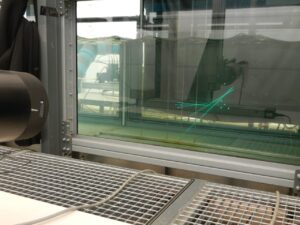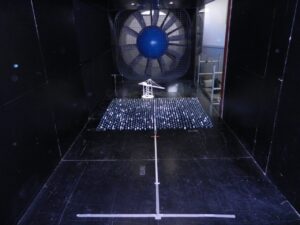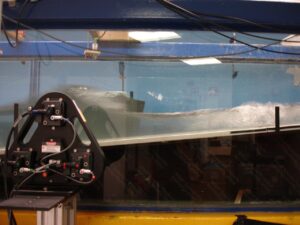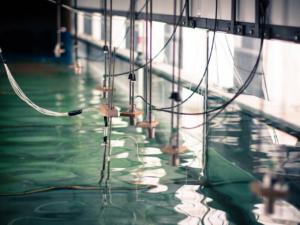



The laboratory is divided into three sections: Marine Engineering Section, Wind Engineering Section and Atmosphere-Ocean Interaction Section. In all cases the behavior and interaction with structures of a fluid, either water (waves, currents) or air (wind) or the interaction between them is studied.
The Marine Engineering Section is dedicated to the testing and study of phenomena involving the water fluid. The activities are carried out in the different facilities of the laboratory: surge tank, surge channel and tilting channel. The main studies carried out are: (1) analysis of wave propagation characteristics, (2) analysis of wave-current interaction, (3) analysis and optimization of wave-structure interaction, (4) analysis and optimization of the behavior of harbor basins, (5) analysis of the behavior of ship-spring interaction.
The Wind Engineering Section is dedicated to the testing and study of phenomena involving the air fluid. The activities are carried out in the different facilities of the laboratory: Boundary Layer Wind Tunnel I and Boundary Layer Wind Tunnel II. The main feature of these facilities is that they can simulate the profile of velocities and intensity of turbulence in the atmosphere (atmospheric boundary layer). The main studies carried out are: (1) analysis and optimization of wind-structure interaction, (2) wind transport of sediments, study of dune formation and movement, (3) optimization of aerodynamics and sports performance, (4) wind field analysis over complex topography, (5) comfort studies in urban areas – urban and architectural planning, (6) dispersion and concentration of pollutants.
Finally, the Atmosphere-Ocean Interaction Section focuses on the study of wave generation and exchange processes between the atmosphere and the ocean, specifically between the atmospheric boundary layer (ABL) and the oceanic boundary layer (OBL). For this purpose, the Atmosphere-Ocean Interaction Channel, CIAO, is the only one of its kind in the world, since it combines the generation of wind, waves and currents at two heights, all independently and reversibly. It also incorporates a rain generation system. The main research lines developed in the CIAO are: (1) wind wave generation processes, (2) interaction between ABL and OBL, (2) estuarine dynamics, (4) wind current generation, (5) combined actions of wave and wind on structures, (6) wave energy generation.
The Laboratory is equipped with state-of-the-art instrumentation for the measurement of all hydrodynamic and aerodynamic variables involved in the processes studied: (1) anemometry by means of PIV-V3V (Particle Image Velocimetry in 3D), LDV (Laser Doppler Velocimetry in 3D), hot wire, unidirectional and omnidirectional pitot tubes (2) wind pressure by means of 8400 pressure system and Initium pressure system, (3) wind forces using force and moment balances, (3) video imaging with high speed camera, (4) free water surface characterization using resistive and acoustic level sensors, (5) water anemometry using 3D Doppler velocimetry, (6) water pressure using pressure sensors.
Contact Person:
María Clavero Gilabert Email: mclavero@ugr.es Telf.: 958.249734